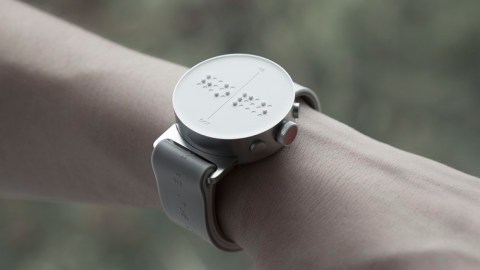The first smart watch for blind people lets them receive texts and notifications

For the 285 million visually impaired people around the world, the technological advancements of our day and the conveniences of everyday life enjoyed by the sighted are rarely experienced. From libraries without braille books, to street signs and smart devices, navigating life is an entirely different and much more difficult experience. Noticing this divide in university, where sighted students could instantly get information from smart devices, while a visually impaired classmate had to lug around heavy Braille books, Eric Kim was inspired to develop a cheap impairment-friendly smartwatch.
The Dot Watch—the first smart watch for visually impaired people—is a wearable device, which instead of presenting information through text and graphics, uses a refreshable Braille display. The display is made of 24 touch sensors and utilizes electro-dynamic cells to relay information. With the help of those sensors the device knows when the finger of the user reaches the last letter on the display and instantly refreshes the screen with new letters. In this way the user can read across the small 43mm (1.7in) radius circle.
In addition to the typical watch functionalities, such as an alarm, accelerometer, and showing time down to the seconds, the watch can also display notifications from social media, text messages, directions, and other customizable information with the help of an app that pairs certain applications with the device. In addition, Dot is an open system, so anyone can develop apps for it.
So far there have already been 140,000 pre-orders of the watch from 13 different countries. English and Korean versions will be coming from the first of April, 2017, and will cost about $290 USD. Dot Inc. has received over $5 million in investment and has secured 31 patents, aspiring to be the leader in the assistive-device market.
The company is also taking an active role in improving Braille literacy across developing countries, where about 75% of the world’s blind population is located. They are pairing with Korea International Cooperation Agency to supply a low cost device—Dot Mini—to 1 million visually impaired people in Kenya.



